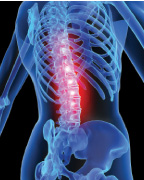| | OverviewOsteoporosis is a disease characterized by low bone mass and deterioration of bone tissue. Eventually, a more fragile bone structure results in fracture, particularly of the hip, spine and wrist. Complicating prevention and diagnosis is the fact that bone loss occurs without symptoms. Several major risk factors contribute to a diagnosis, among them: Age 65 or older.
Vertebral compression fracture or low-trauma ("fragility") fracture after age 40.
Family history of osteoporotic fracture.
Long-term (> 5 months) use of glucocorticoid therapy (e.g., prednisone).
Certain medical conditions, e.g., early menopause (< age 45), celiac disease, Crohn’s disease, tendency to fall, osteopenia, hypogonadism, etc.
Bone is a living tissue and is constantly building and destroying itself. Peak bone mass is achieved at age 16 in girls and age 20 in men. Women and men alike begin to lose bone in their mid-30s. Estimates of prevalence vary, but based on common assumptions of one in 4 women and at least one in 8 men over age 50, about 2 million Canadians suffer from osteoporosis. Men are thought to be less exposed due to their higher peak bone mass, no menopause-related acceleration in lost bone mass, less likelihood of fall, and shorter lifespan.2 With an aging population, incidence (new cases) is expected to double worldwide in the next 25 years.3 Research FindingsWhile women are twice as likely to have osteoporosis, they are six times more likely than men to use bisphosphonates, the most common form (95%) of drug therapy. This leads to concerns about whether men are being diagnosed and treated as effectively as women.4 Early treatment with effective drugs can reduce the rate of hip fractures by 45% – 50%, and even more for vertebral fractures.
New biologic therapies will enter the market in the next few years, promising greater efficacy but at a significantly higher cost. These new products will be injected twice yearly, providing an opportunity for much better adherence to therapy. At present, only about 51% of patients adhere most of the time (80%) to their osteoporosis treatment after one year.5
The direct economic cost of osteoporosis in Canada has been estimated to be between $1.3 (Osteoporosis Canada) and $1.9 billion (International Osteoporosis Foundation, working Canadians, using 2000 figures). A 2001 study of Ontario patients showed an average treatment cost of $27,000 per hip fracture over one year. Indirect costs, such as lost income to the employee, lost production to the employer, and health insurance premiums, were not calculated.6
Statistics Canada reported that 10% (3.3 million) have inadequate levels of vitamin D. Those Canadians are at risk of bone health issues, including greater risk of fractures and falls, but also breast and colorectal cancers, poor immunity, cardiovascular disease and multiple sclerosis. The most at-risk group was men ages 20-39. Of those with inadequate levels, more were men (12.9% inadequate) than women (8.3%).
During Spring and Summer in Canada, normal daily sun exposure produces enough vitamin D, but at other times, production is inadequate. People with darker skin produce less vitamin D, and those over age 50 also produce lower levels.7
Adults under age 50 should consume 1,000 mg of calcium a day. Over age 50, intake should be increased to 1,500 mg. Adults need 400 IUs of vitamin D per day in order to absorb the calcium; beyond age 50, 800 IUs are recommended.
A 2008 report by Osteoporosis Canada indicates provincial health plans provide significantly different access to diagnostic tests and osteoporosis drugs. Employer drug plans that follow weak government formularies will present the same problem; employers with better coverage may find their plans used more frequently.
Sources: 3. International Osteoporosis Foundation (IOF), 2002. Invest in Your Bones: Osteoporosis in the Workplace. p.17. 4. Canadian Institute for Health Information, 2009. Rise in use of common osteoporosis drugs among Canadian seniors. News release, February 12. 5. Adherence figures supplied by Amgen. 6. Op cit. IOF, 2002. Invest in Your Bones: Osteoporosis in the Workplace. p.7. 7. Statistics Canada, 2010. Vitamin D status of Canadians as measured in the 2007 to 2009 Canadian Health Measures Survey. Health Reports 21(1), 47-55. |


